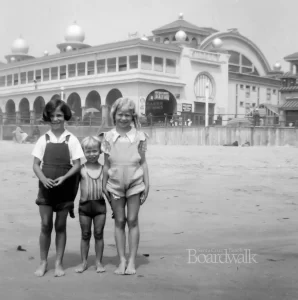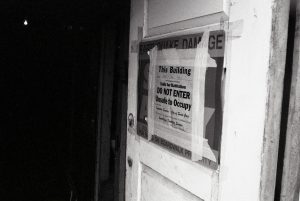
In a previous blog, I described the events that transpired in the hours immediately following the violent 1989 Loma Prieta earthquake at the Boardwalk and Casa Del Rey Hotel. You can read that HERE.
After weathering a long night punctuated by aftershocks, the sun rose on an unseasonably warm Wednesday, October 18, 1989. Residents of the Casa Del Rey were camped outside and confronting their new stark reality, their retirement hotel was not habitable. Based on the previous night’s assessment by the company’s architect, we believed the hotel had been damaged beyond repair and deemed it no longer safe for residents. As soon as it could be safely arranged, residents were allowed into the shattered building with Seaside Company and volunteer staff for quick expeditions to retrieve personal belongings and essentials.
Right away, hotel managers began the formidable task of relocating their former guests to new abodes, a more arduous task than initially anticipated. Initially relying on temporary phones in the parking lot and unused space in the Cocoanut Grove building, staff and volunteers called residents’ families and emergency contacts. About half of the residents were quickly re-established with family and friends. It was sad to learn some families were unable to house their own relatives. The Seaside Company’s Carousel Motel on Riverside Avenue became home to many residents whose relocations proved more challenging. With two downtown residential hotels emptied of their occupants in addition to the Casa Del Rey, it took the remainder of the year to successfully reconnect all of our residents with family and friends, other residential facilities, support agencies like adult protective services or shelters.
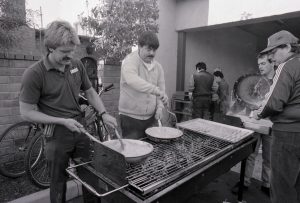
Dedicated Boardwalk employees, least impacted personally by the quake, came to work that morning, regaling each other with descriptions of the shaking effects they saw. With foodstuffs drawn from company kitchens and stores, hotel and Cocoanut Grove chefs cooked and served breakfast and dinner that week in the main parking lot to residents and staff alike. Meal service then moved to the Carousel Motel’s parking lot.
 Startling aftershocks that week were disquieting reminders of the quake’s initial jolt. As an example of the community’s hyper-sensitivity, a concerned citizen placed a frantic call to alert us that someone was stuck on the Sky Glider ride. Her frazzled gaze mistook one of our cave people, who regularly travels by gondola above the Boardwalk, as a stranded visitor. All was well!
Startling aftershocks that week were disquieting reminders of the quake’s initial jolt. As an example of the community’s hyper-sensitivity, a concerned citizen placed a frantic call to alert us that someone was stuck on the Sky Glider ride. Her frazzled gaze mistook one of our cave people, who regularly travels by gondola above the Boardwalk, as a stranded visitor. All was well!

Company architect, Bill Bagnall, was back early on Wednesday too. With the hum of generators in the background and the whoop-whoop-whoop of occasional helicopters circling in the air, he and our senior maintenance heads inspected the remaining Boardwalk facilities – inside and outside. Their journey was video-recorded to document the quake’s devastation. Reviewing the VHS tape of actual images from our walk-through that week, certainly refreshed my memory.
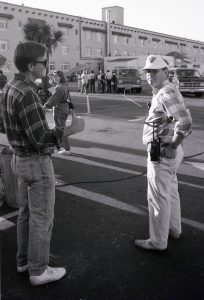
Almost all Boardwalk spaces had been turned upside down. Offices were disheveled piles of cabinets, shelves, papers, desks, computers, and chairs scattered everywhere. Maintenance work areas displayed the quake’s havoc with helter-skelter arrays of equipment, parts, collapsed storage racks, and other odds-and-ends thrown about. Anything untethered in our restaurants, games and retail concessions added to the chaotic mess. Thankfully though, the Boardwalk was found to be structurally intact.
With only a damaged chimney, the company’s Sea & Sand Inn was soon filled with out-of-area emergency responders.
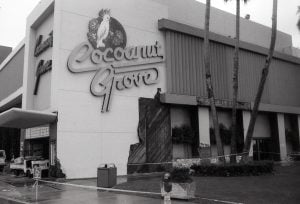
Damage to the Cocoanut Grove was mostly cosmetic. Its western walls took the biggest hit. Split and damaged sheetrock appeared throughout the inside. Exterior wall surfaces were pock-marked and cracked with holes. Remnants of a disco ball littered the Bay View Room floor. The Ballroom’s hardwood and carpeted floor suffered damage from several hours of drenching water that also seeped into the Bay View Room and Lounge. Shards of plates, cups, and glasses littered the kitchen floor. The contents of a fully-stocked Sun Room bar littered the floor, remnants of an event that never happened. Amazingly, only one panel in the Sun Room’s expansive glass roof was shattered. Broken glass and windows were everywhere throughout the Grove and Plunge buildings.
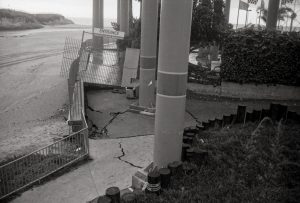
The river-end of the Boardwalk evidenced the most damage. Cracks and crevices could be seen throughout the River Parking Lot and around Boardwalk Entrance 6 near the railroad trestle. Cement surfaces revealed the consequence of the quake’s side-to-side and up-and-down undulation. A section of the seawall pulled away from the deck – or vice versa. Several columns of the flume ride towers came askew and pulled the ride’s trough apart as they twisted. A soil engineering assessment commenced the week after the quake to guide the repair process and resetting of this area.
The river basement’s floor was a mess of cracked cement, the result of hydrostatic pressure released from liquefaction in the sandy ground below. The flume ride’s water holding tank had ruptured, releasing all its 60,000-gallon contents throughout the basement. Thankfully though, the 90,000-sf area was structurally intact.

The Beach Street entrance to the Plunge building, housing a miniature golf course at that time, had separated from the main building and hung precariously ajar. We pulled that structure down immediately for safety’s sake. Since planning had already commenced for what would become Neptune’s Kingdom, we decided to proceed with the construction of that new attraction and not repair the old 1907-vintage building. We moved to obtain a demolition permit, accelerated plans, and commenced the development of Neptune’s Kingdom. It opened in June 1991.

The quake caused the flagpole atop the Casino building’s dome to bend, and the drooping flag became the perfect photographic image for a broken town. The flagpole was immediately removed to prevent the image from being broadcast by any of the numerous national media photographers swarming Santa Cruz.
Our iconic Giant Dipper weathered the raucous shaking in great form. However, its station’s transfer table, by which its trains are removed and added to the main track, had to undergo re-adjustment.
By mid-December, our Beach Bandstand was demolished, and its remnants carried off. We arranged a temporary structure for use during the 1990 season. Plans were developed for a new permanent structure, but the cost became prohibitive. The transient stage has been in use ever since.
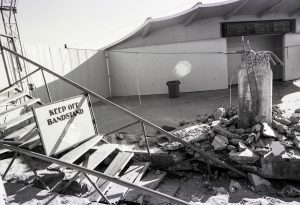 General Manager Ed Hutton chaired earthquake recovery meetings with staff every few days for two weeks. He and Seaside Company President Charles Canfield set the repair priorities as new findings on damage and prospects for repairs became known. Maintenance staff and additional construction support worked each day over several weeks to ready the Boardwalk for when it would open again. An amusement ride safety specialist was brought in to review and inspect all Boardwalk rides before reopening to the public. Sensitivity to the plight of downtown merchants dictated we not be in a rush to re-open.
General Manager Ed Hutton chaired earthquake recovery meetings with staff every few days for two weeks. He and Seaside Company President Charles Canfield set the repair priorities as new findings on damage and prospects for repairs became known. Maintenance staff and additional construction support worked each day over several weeks to ready the Boardwalk for when it would open again. An amusement ride safety specialist was brought in to review and inspect all Boardwalk rides before reopening to the public. Sensitivity to the plight of downtown merchants dictated we not be in a rush to re-open.
However, with water pressure soon recovered in the Cocoanut Grove, priority was given to repair walls, floors, and carpets to have that facility available for the weekend of October 28 and 29. That permitted the annual Good Times Halloween Ball to occur as planned. The Santa Cruz Chamber of Commerce’s annual dinner, also planned for that weekend, was rescheduled for after the New Year.
 On November 4th and 5th, the Boardwalk partially reopened for an Earthquake Relief Benefit. The weekend commenced with a Community Prayer Breakfast in the Cocoanut Grove featuring inspirational words from cancer-stricken Dave Dravecky of the San Francisco Giants. With special pricing in place, local families turned out for some much-needed Boardwalk fun to benefit earthquake disaster relief. $22,000 was raised. Little promotional fanfare was given outside of our county as Highway 17 was only open to escorted one-way traffic during specific hours until Thanksgiving weekend. Sunday Brunch in the Sunroom commenced the next day.
On November 4th and 5th, the Boardwalk partially reopened for an Earthquake Relief Benefit. The weekend commenced with a Community Prayer Breakfast in the Cocoanut Grove featuring inspirational words from cancer-stricken Dave Dravecky of the San Francisco Giants. With special pricing in place, local families turned out for some much-needed Boardwalk fun to benefit earthquake disaster relief. $22,000 was raised. Little promotional fanfare was given outside of our county as Highway 17 was only open to escorted one-way traffic during specific hours until Thanksgiving weekend. Sunday Brunch in the Sunroom commenced the next day.

The Casa Del Rey Hotel’s expected demise was officially confirmed within a few days following the quake. On November 13, 1989, the wrecking ball first struck the 80-year old building and leveled the hotel by month’s end. It proved to be the only building in Santa Cruz victimized by liquefaction. Ironically, as the wrecking ball swung, the company paid the last $50,000 for improvements to that building that had been underway before the quake hit.
It was sad to see the historic building come to such an ignominious end. Sadder still, were subsequent newspaper quotes of heartfelt memories of happy times from former residents recalling their golden years at Santa Cruz Beach.
Longer-term repairs at the river end of the Boardwalk got underway by year’s end. Our flume ride opened in June 1990, its twisted towers reset and water holding tank rebuilt. The Cave Train and Great Auto Race rides ran that season also, with the track and roadway releveled. River basement flooring was repaired in sections, taking a full year to complete. Seawall and surface repairs around Entrance 6, near the railroad trestle and River Parking Lot, were all completed late spring.
Altogether, total repair costs to the Seaside Company approached $3.5 million.
 The earthquake damaged and closed Riverside Avenue Bridge severing the major automobile entry route to the Santa Cruz Beach area. A traffic detour diverted inbound Highway 17 traffic entering from Ocean Street to Front Street on the eastern fringe of the city’s downtown. The beach-bound journey continued along Front Street to the beachfront and back, throughout all of 1990. A novel paper “mapkin,” imprinted with a diagram of the detour’s routing, was well distributed throughout the Santa Cruz area. A new 4-lane Riverside Avenue Bridge opened in April 1991, replacing its former 3-lane counterpart.
The earthquake damaged and closed Riverside Avenue Bridge severing the major automobile entry route to the Santa Cruz Beach area. A traffic detour diverted inbound Highway 17 traffic entering from Ocean Street to Front Street on the eastern fringe of the city’s downtown. The beach-bound journey continued along Front Street to the beachfront and back, throughout all of 1990. A novel paper “mapkin,” imprinted with a diagram of the detour’s routing, was well distributed throughout the Santa Cruz area. A new 4-lane Riverside Avenue Bridge opened in April 1991, replacing its former 3-lane counterpart.
Once again, only a few names of Boardwalk staff have appeared in this recounting. Space does not permit me to cite the names of all our dedicated Boardwalk staff who worked tirelessly to repair and cause the Santa Cruz Beach Boardwalk to rise from the quake’s rubble.
Are there any lasting memories of the Boardwalk’s recovery that stand out in your mind? Let me know.
’til next time
-Ted



